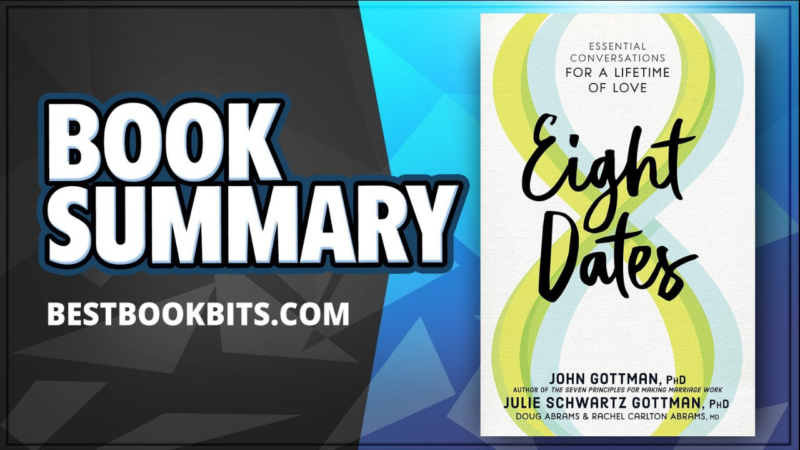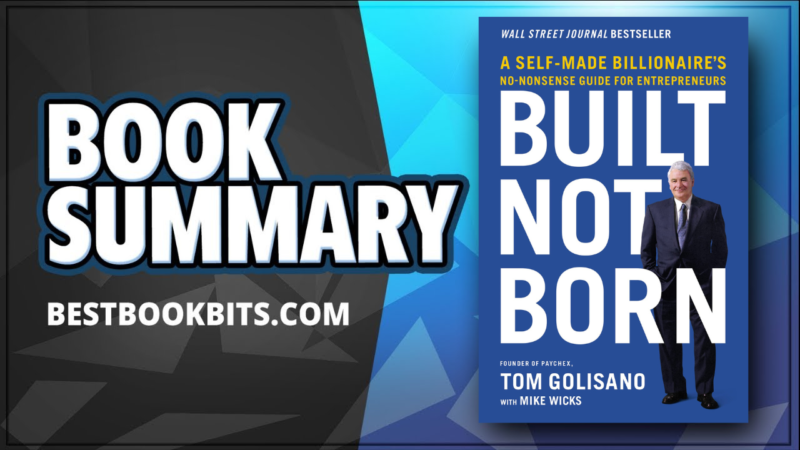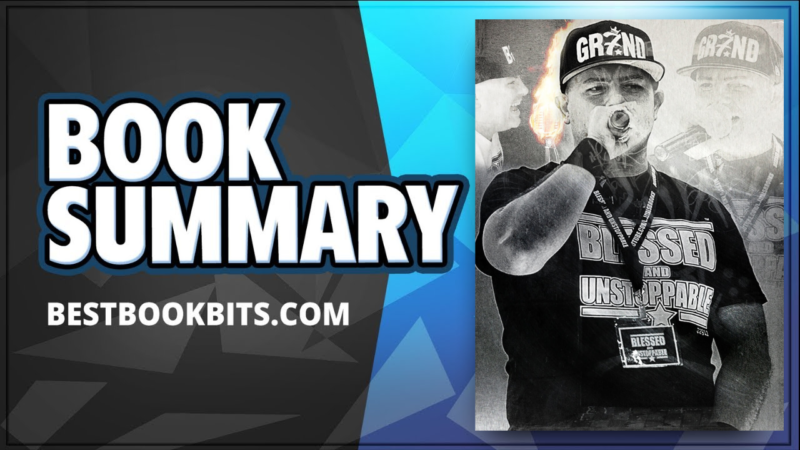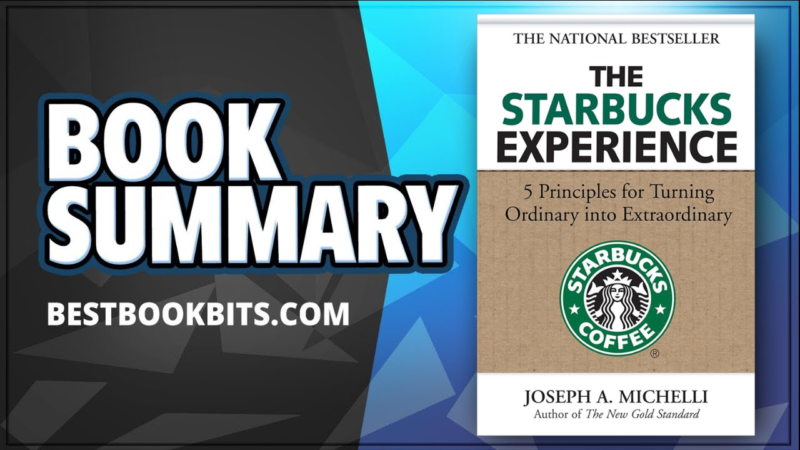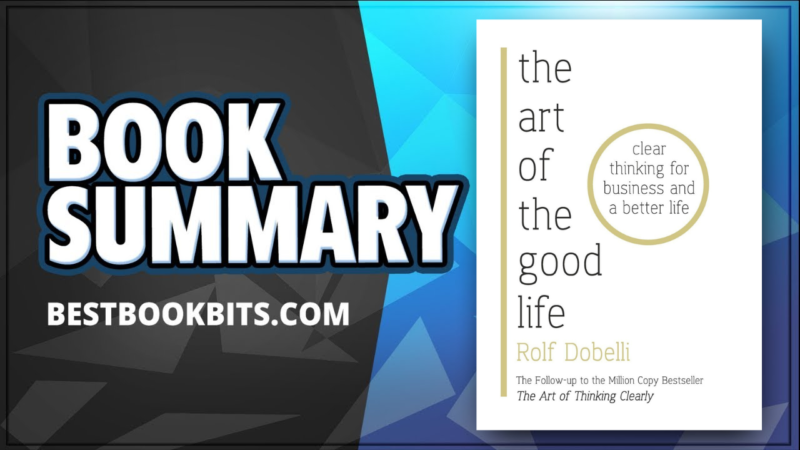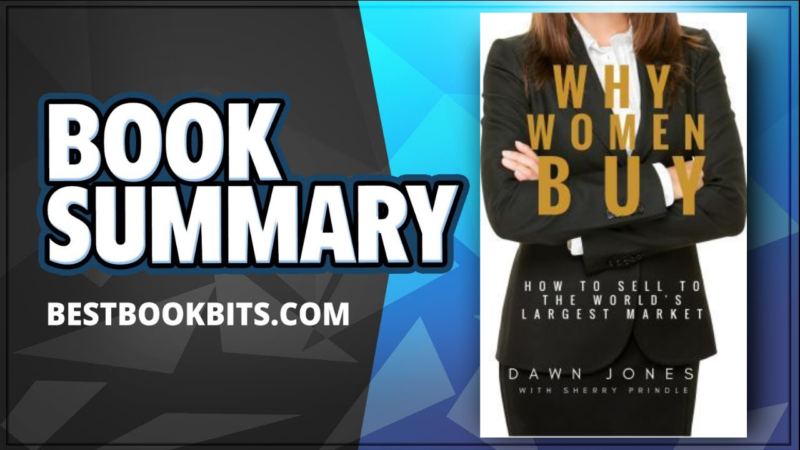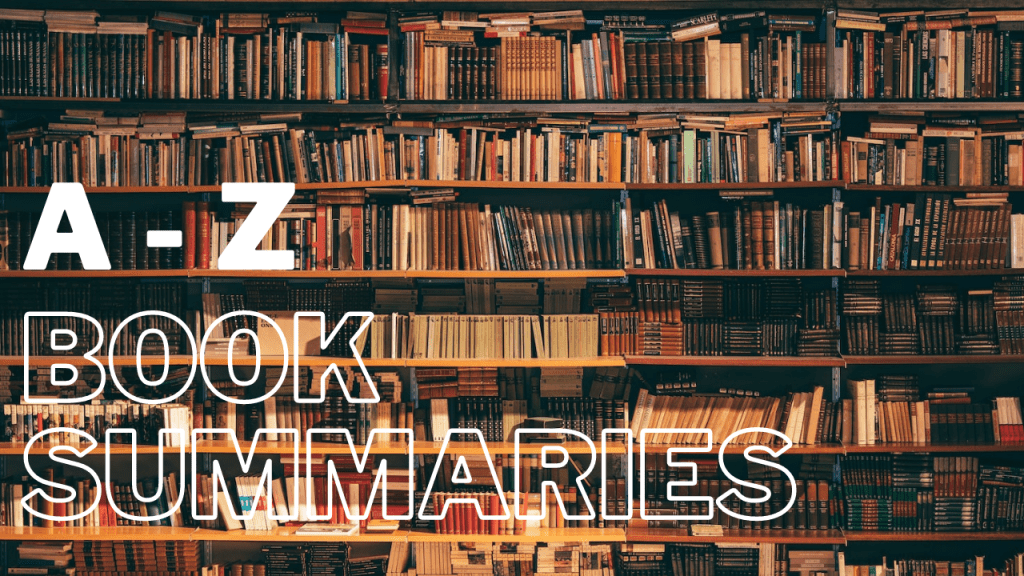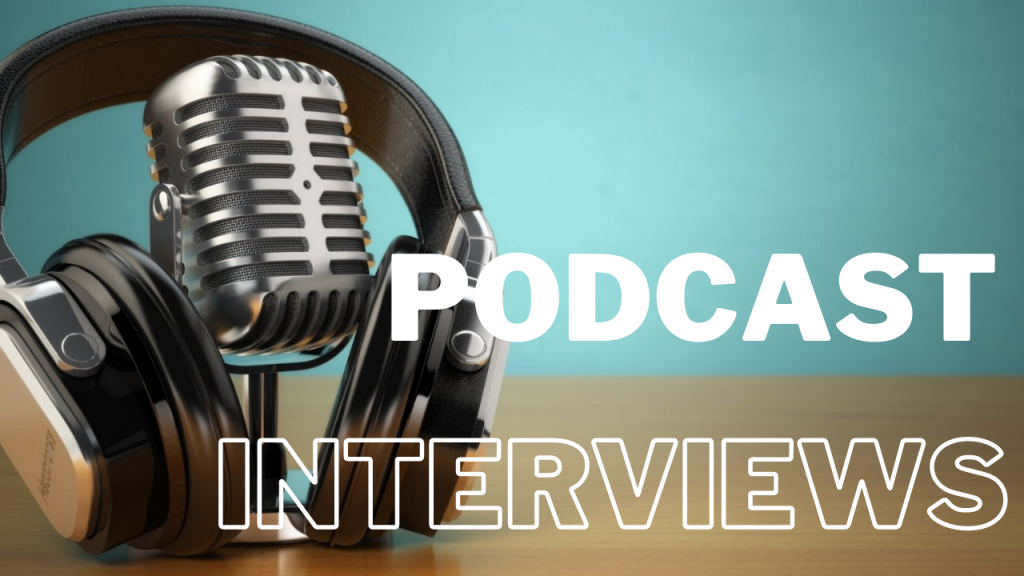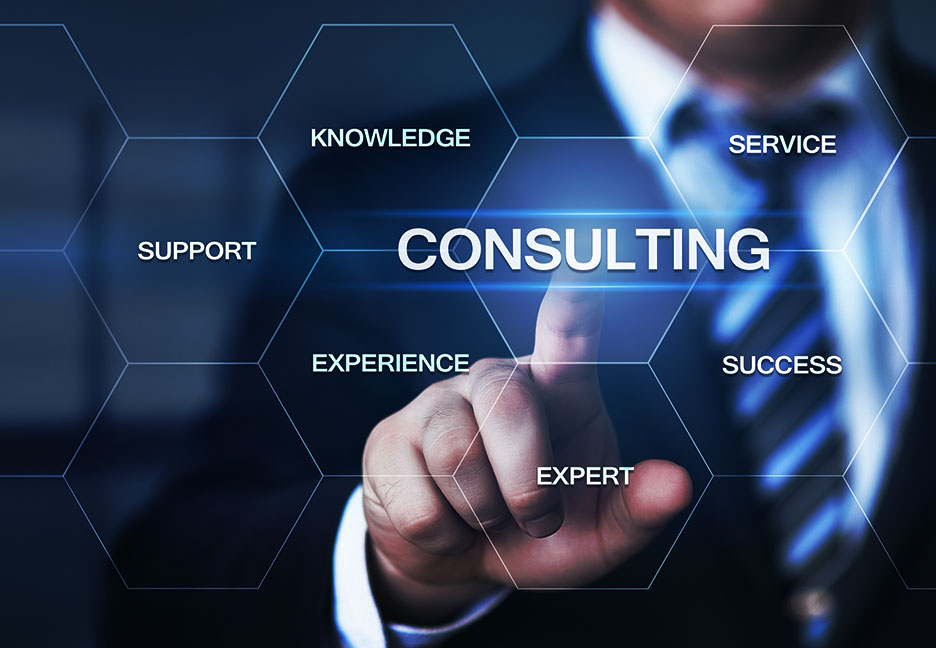
Eight Dates by John Gottman | Powerful Relationship Lessons & Book Summary
FOLLOW US HERE > |YouTube | Podbean | Website
Eight Dates: Essential Conversations for a Lifetime of Love by John Gottman PhD, Julie Schwartz Gottman PhD, Doug Abrams, Rachel Carlton Abrams MD
Strengthen and deepen your love with a fun, ingenious program of eight life-changing conversations—on essential topics such as money, sex, and trust—from two of the world’s leading marriage researchers and clinicians.
Navigating the challenges of long-term commitment takes effort—and it just got simpler, with this empowering, step-by-step guide to communicating about the things that matter most to you and your partner. Drawing on forty years of research from their world-famous Love Lab, Dr. John Gottman and Dr. Julie Schwartz Gottman invite couples on eight fun, easy, and profoundly rewarding dates, each one focused on a make-or-break issue: trust, conflict, sex, money, family, adventure, spirituality, and dreams.
Interactive activities and prompts provide motivation to stay open, stay curious, and, most of all, stay talking to each other. And the range—from the four skills you need for intimate conversation (including Put Into Words What You Are Feeling) to tips on being honest about your needs, while also validating your partner’s own emotions—will resonate, whether you’re newly together or a longtime couple looking to fortify your bond. You will discover (or rediscover) your partner like never before—and be able to realize your hopes and dreams for the love you desire and deserve.
Eight Dates Key Idea #1: Trust and commitment are the cornerstones of any successful long-term relationship.
Every relationship comes to a point where commitment begins to waver. Maybe you met an interesting person, and you begin to consider how your life might be with them instead of your partner. It’s one thing to briefly fantasize about that alternate universe. It’s another thing to do so regularly. If this is the case, you may be experiencing a lack of commitment in your current relationship.
Commitment means being there for your partner, no matter what. Instead of allowing yourself to get involved in situations that might lead to infidelity, you avoid these situations altogether, as you know they will negatively impact the trust in your relationship. And instead of seeking out others who might not have the flaws your partner does, you talk about your feelings and needs with your partner openly. That’s true commitment, and all long-lasting relationships are built on it.
The bedrock of commitment is trust. Trust is the oxygen that helps every relationship breathe. Trust isn’t something that happens overnight, but over months and years of helping a relationship grow. It’s built by being on time, keeping one’s promises and always being there for your partner when they’re in need. Conversely, trust is damaged when one does the opposite of these things or engages in deceitful behavior.
One of the most important ways to build trust in a relationship is through conversation. This leads us to the first of the eight dates, which is all about trust and commitment. Before the date, identify what trust and commitment mean to you personally. It can be helpful to think about your parents, and how trust and commitment affected your family life growing up. Also, try to come up with a few examples of how your partner has shown their commitment to you recently.
When date night arrives, it’s time to have a conversation. Take turns asking and answering questions like, “When was the last time you didn’t trust me and what could I have done differently?” Or perhaps “What can I do to prove that I am committed to you and our relationship?” And finally, “What are the differences between our definitions of trust and commitment – and how can we resolve them?”
Eight Dates Key Idea #2: Conflict is part and parcel of any relationship, but there is a correct way to fight.
All couples fight. In fact, fighting can be a therapeutic and even healthy way for couples to express their differences and learn more about each other. Research shows that the happiest couples are the ones who can handle conflict, listen to their partner and try to understand their point of view. But if done wrong, fighting can exacerbate unstable relationships and lead to incidents that cause irreconcilable breakups.
To help make sure your relationship doesn’t go down that road, go on date number two. This date is all about addressing conflict. Before going on it, you should identify potential areas of conflict in your relationship.
Start by individually listing the most significant differences between you. Perhaps you and your partner have different approaches to drugs and alcohol. Or perhaps you have different definitions of cleanliness around the house. While listing all these differences, also consider possible ways you can accommodate each other’s preferences. But also be ready to accept the possibility that some differences cannot be resolved.
With this exercise in hand, it’s time to go out on your date. It’s best to have this date somewhere more private, in case things get heated. Take turns talking and listening. Go through your lists of differences one by one, explain why the issue is important to you and explore possible compromises. It might also be a good idea to discuss how each of you experienced conflict in your respective families, as this can directly impact how you handle conflict today.
Now, it’s possible that this date ends in a fight. Luckily, there are some ways you can heal these fresh wounds right away and turn the fight into a learning experience. For example, once the fight has calmed down, take turns explaining how you felt during the fight. Try to figure out what triggered it, so you can both avoid this conflict in the future. Finally, discuss how you might act differently in your next fight. Was there some point where your partner crossed a line? Figure out ways you can engage in conflict more productively.
Eight Dates Key Idea #3: Sex and intimacy might be hard topics for some couples, but it’s necessary to talk about them.
When it comes to talking about the “birds and the bees,” most couples run into trouble. In fact, a minority of couples talk openly about sex. This is unfortunate, as even the mere act of talking about sex can lead to better sex. Research shows that couples that discuss their sex life openly have more sex than those who don’t. And the women in these couples have more frequent orgasms.
But for many couples, particularly those who come from different backgrounds, the next date on our list might cause some difficulty. Take one couple, Katya and Ethan. Katya grew up in a family that openly discussed sex, but Ethan says that his father would’ve passed out if he heard the word “vagina.” Coming from these very different backgrounds meant that talking about sex was difficult for them. But by using the questions provided by the authors, Ethan and Katya went on a successful sex and intimacy date. They were able to discuss what they liked and didn’t like about their sex life.
Before we get to the questions, let’s look at location, a key part of this sex and intimacy date. You should aim for a candlelit dinner at a restaurant, or perhaps at a secluded beach cove or public garden. This date should be romantic, after all – if it goes well, it may end in love-making. Make sure you’re wearing something sexy!
Before your date, reflect on ways to approach the topic of sex with your partner. If you find sex difficult to talk about, make sure to consider why that is. At the end of the day, there is no correct way to have this conversation. The key is honesty and openness.
Once the date commences, it’s time to ask and answer some questions. What are your favorite sexual experiences you and your partner have shared? What do they do that turns you on? What sexual activities do you want to try, but have never dared to ask for? While answering these questions, keep a couple of things in mind. For one, try to be as specific as possible when it comes to describing, say, which parts of your body enjoy being touched. Or what your favorite sexual acts are. Vagueness only leads to confusion.
Eight Dates Key Idea #4: Resolving issues related to work and money is integral for any successful relationship.
Before the 1960s, men worked while women took care of the household, an old-fashioned and sexist configuration. Despite significant shifts in the last decades, the division of labor in a partnership still presents a problem.
Work doesn’t just refer to a paid profession. Non-paid work around the house would cost approximately $90,000 per year if you hired someone to do it for you. What’s more, a 2007 Pew Research study found that sharing housework was the third most important element of a long-lasting marriage, right after being faithful to one’s partner and a healthy sex life.
When it comes to labor, it’s important that every couple strikes a balance between earning paychecks and contributing around the house. Even more critical is to regularly talk about whether you think you’re both putting in equal effort. The fourth date isn’t just about finding a balance in this area. It’s also about balancing out the fruits of your labor – money.
As with the previous dates, family history can play a big role in the way we perceive the world. Money is no exception.
Take Trevor and Adam. While Trevor loved to spend, Adam was more inclined to save. This stemmed from their different childhood experiences with money. Trevor’s father had always promised to take them on adventures but died at the young age of 35. So when Adam inherited a sizable amount of money, Trevor thought it best to spend it on traveling. But Adam grew up poor, and his family never had money to fall back on. While he also wanted to travel, he preferred to put his inheritance directly into a savings account.
These differences highlight the importance of preparing for your work and money date. This preparation involves asking yourself some questions about your family history with money. Did your parents have savings? Did you take regular vacations? How frugal were your parents? Once you’ve answered these questions, it’s time to go on a date – and it should be as cheap as possible – no fancy restaurants this time. Consider getting take-out and having the date at home.
Take turns sharing your respective family histories with money. Continue by sharing three ways your partner contributes to the relationship – monetary or otherwise – that you really appreciate. And make sure to be open about your hopes and fears regarding money and the future.
Eight Dates Key Idea #5: Decisions about family and children are serious and need to be discussed extensively.
One topic that can be a real deal-breaker for a couple is whether or not to have children. This can also be a bank-breaker. Raising a child to age 18 in the United States costs on average $233,610.
But the potential problems of raising a child don’t stop there. John Gottman, one of the authors, observed a 67 percent drop in marital happiness in couples who had a child within four years of getting married. And this marital happiness doesn’t come back until after the child has left the nest – if the parents haven’t already divorced by this point. So, what sort of recommendations can prospective or current parents follow if they want to avoid this?
Firstly, regardless of your gender or whether you’re in a hetero or same-sex relationship, both partners need to involve themselves in the pregnancy and birth of the child. Studies of heterosexual relationships show that when the father is involved in the pregnancy, there is less of a chance of conflict and more chances for continued marital happiness.
Secondly, parents need to prioritize their intimacy with each other. This involves making sure you connect regularly, whether through date nights or simply continued communication. Raising children is stressful, and you need to communicate and avoid withdrawing from each other. With this in mind, it’s time to plan out your next date night. This one will be all about family and children and should take place somewhere frequented by children. Consider a public playground or a family-friendly restaurant.
The questions you and your partner should ask each other on this date are probably quite obvious. The elephant in the room is, of course, your idea of the perfect family. Does it include children? If so, how many? What sort of problems might you encounter while raising children? How can you prevent or tackle those problems?
If you’ve already decided you don’t want children, that doesn’t mean you should skip this date completely. Family involves more than just children, after all. In this case, you might consider asking about your partner’s closest family. What can you do to strengthen your relationship with this family? Keep in mind this might be relatives or friends.
Eight Dates Key Idea #6: Play and adventure are integral parts of any successful relationship.
When was the last time you and your partner went on an adventure? Or simply acted a bit silly together? If you’re finding it hard to remember, it’s probably time for you to introduce a bit of play into your relationship. The importance of having fun with your partner cannot be overstated. Sadly, in today’s world of long work hours and stressful family demands, play often finds itself at the bottom of our to-do lists.
If this sounds familiar, consider how you might cultivate joy in your relationship. Howard Markman, director of the University of Denver’s Centre for Marital and Family Studies, has been studying the fun that couples have since 1996. For him, the numbers speak for themselves – couples that play and laugh regularly are happier couples.
The sixth date is all about play and adventure. To prepare, think through all the possible fun things you could do with your partner. Particularly things you haven’t done in a long time, or haven’t ever tried. When was the last time you went to a concert? An amusement park? Have you ever taken a dance class together? What about simply playing in the mud on a rainy summer day?
Once you have a list of possible activities, it’s time to plan a fun date! Try to be as spontaneous as possible. Why not take a day off work and have a date in the morning? Or in the middle of the night? The sky’s the limit for how creative you can be with this date.
When you’re on the date itself, you need to make time for some conversation. What does adventure mean to you and your partner? What’s the last thing you can remember doing that was only about having fun? What adventures do you want to embark on before death?
During the date, make sure to compare your preparation notes. Which activities are on both of your lists? Some couples might find that their ideas of fun are quite different. But don’t be daunted by this. Remember that having fun is often about trying new things. What are some of the things on your partner’s list that you can imagine trying? Remember, doing new things together keeps the novelty of the relationship intact!
Eight Dates Key Idea #7: Growth is constant in every relationship, and finding spiritual meaning can be part of that.
Some say change is good. Others say that change is necessary. In relationships, change is simply inevitable. We change, our partners change and our relationships change. Some relationships end due to irreconcilable differences in goals or personalities. But the strongest couples are those which accommodate each person’s changes and allow these changes to help them grow as a couple.
Take Erica and Jake. Erica decided to give up her high-paying marketing job at a big tech firm to achieve her dream of becoming a painter. Jake supported her every step of the way, as he knew how important it was to her. Their money dried up, and they had to downsize their apartment. They gave up basic amenities like cable television. But at every step of the journey, they talked about the changes happening around them, and they continued to support each other through these life-changing decisions. In Erica’s words – they have the “best life ever.” They might not have money, but they have meaning, and they have each other.
Keep Erica and Jake in mind when preparing for date number seven, which is about growth and spirituality. One exercise to complete before the date is to figure out what goals you share with your partner. Do you share the same goals? Does your partner respect your accomplishments? What do you want to have achieved when you reach old age?
You can also bring an object that honors your partner along with you on this date. This might be a photo or other special objects connected to them. When it’s time to go on the date, there are many questions you might ask on the topic of spirituality. Was your partner religious as a child? What do they consider sacred? How do they find inner peace when times are hard? What sort of beliefs would they pass on to their children? Spirituality goes hand-in-hand with meaning and change, so be prepared for some deep, philosophical talks on this date!
Eight Dates Key Idea #8: To create a lifetime of love, always honor your partner’s dreams.
Everyone has dreams, but a lot of us don’t find the time to pursue them. Modern life can make it hard to align a family, full-time job and dreams. But that’s where having a partner comes in. Partners should always help each other achieve their individual dreams, even if that means sacrificing their own. Sometimes you have to put your dreams on hold while helping your partner achieve theirs. They will do the same for you when the time comes.
This is exactly what Doug and Rachel did. During the early days of their relationship, they were inseparable and totally in love. But Doug had a dream – he wanted to go to Israel for a year to explore his roots. While initially sad, Rachel knew she couldn’t stand in the way of Doug’s dreams. So she encouraged him to go.
Upon his return, he planned to join her in New York and begin climbing the career ladder. But Rachel’s dreams had changed. She had decided to go to medical school 3,000 miles away from New York. For him, the decision was clear – he gave up on his New York dreams and moved with her. His sacrifice made Rachel feel loved. Throughout both experiences, they learned that honoring each other’s dreams sometimes involved putting their own on hold.
This story brings us to the topic of the final date – dreams.
To prepare for this date, write a list of all your dreams, the stories behind them and how your partner can help you fulfill them. You should also note any shared dreams you’ve already discussed, and how you can move forward in helping each other achieve them. The location of this dreamy date should be inspiring – perhaps somewhere you can watch a beautiful sunset.
Now it’s time to get deep. Questions you should both ask and answer include whether you had dreams as a child, whether your parents helped you to fulfill your dreams and which of your dreams is the most important to you. Once you know about your partner’s dreams, it’s up to you to figure out how to honor them. By doing so, you’ll help your relationship last forever.
Built, Not Born by Tom Golisano | Book Summary
FOLLOW US HERE > |YouTube | Podbean | Website
Built, Not Born: A Self-Made Billionaire’s No-Nonsense Guide for Entrepreneurs by Tom Golisano
Self-made billionaire and Paychex founder Tom Golisano understands the fears, risks, and challenges small-business owners face every day. He has launched and grown his own highly successful business and mentored dozens of entrepreneurs, helping them build their own fruitful companies.
Golisano knows how nervous aspiring business owners are about the risks of entrepreneurship. Now, he’s sharing the startup-to-exit secrets to success and how he turned $3,000 into $28 billion dollars.
Built, Not Born shows you:
- How going against the grain can be a great strategy for finding business opportunities and why it pays to question conventional wisdom.
- Why the pregnant pause can be an effective weapon in negotiations and when interviewing potential employees.
- Why a prenuptial or even a postnuptial agreement is critical to any business owner.
- What potential buyers and funding sources look for, and the best way to present a business plan.
- And finally, the key growth and leadership strategies that have helped Paychex sustain its incredible level of growth and profitability.
Built, Not Born provides a direct and practical approach on how to overcome everyday challenges. This essential handbook is a key resource for current and aspiring entrepreneurs on how to start, grow, and operate a successful business.
Question everything.
The most successful entrepreneurs look at how businesses operate, study internal processes, team dynamics, relationships and the mistakes people make. They’re never satisfied with the way things are, just because they’ve always been that way. It’s the same for you. Your entrepreneurial journey starts with questioning everything in existence.
Entrepreneurship is risky. So is nine to five.
Even if you’re fortunate enough to land a stable job at a good company, you’re always at the whim of a bad boss. On top of that, you can’t sell a job or pass it along to your generations. Successful business on the other hand can warrant income and security even in your retirement days. Not only that, it can outlive you.
Look out for opportunities.
If you’ve ever sat next to a food truck and counted the number of patrons purchasing food and then multiplied this by the average amount spent and then extrapolated what the business owner would earn in a typical lunch period, you’re probably an entrepreneur. Natural entrepreneurs are curious, constantly questioning and challenging the status quo.
Projections mean nothing without an action plan.
Inflated numbers and unrealistic graphs mean nothing if you haven’t done your homework and are unwilling to put in the action.
Don’t go to a fundraising pitch without three things.
Executive Summary: This is a one or two-page summary of your business concept, the industry, your market and the highlights of how your business will operate. The executive summary gives the investors a quick glimpse into what your business is about.
Profit and Loss Statement (Income Statement): This is a one-page assessment that gives investors insights into your financials.
Human Resources (Personnel): Investors want to know whether both you and your management team has product and market knowledge to achieve the returns they’re looking for.
Understand the financial statements.
The Balance Sheet: A balance sheet is a snapshot of your business at a set moment in time. Your balance sheet shows your assets (cash, accounts receivable, inventory, prepaid expenses, furniture, equipment, etc.) and liabilities (accounts payable, unpaid expenses, etc.).
If you take your assets and subtract your liabilities, you have your company’s ‘net worth’. Your net worth contains the profits you’ve made and money you or your shareholders have invested. This snapshot can be taken at any time.
The Profit and Loss Statement: Also known as the income statement. This is a recap (either a month, a quarter or a year) of all the revenues you brought into the company and all the expenses you incurred in maintaining your business. The difference between the two is either your profit or your loss.
Cash Flow Spreadsheet of Forecast: A cash flow forecast predicts the company’s monthly revenue and expenses over a period of time, usually twelve months. It shows your monthly opening bank balance, revnees, expenses and monthly closing balance. Revenue predictions are usually based on your sales forecasts. A cash flow forecast is a useful tool both for monitoring your company’s performance and for identifying your cash requirements ahead of time.
Six key questions to ask before starting your venture
- Is your market large enough?
- Can you make a decent profit margin?
- Can your company deliver?
- Is it short-lived or sustainable?
- Do you have enough capital?
- Can you keep up with technological changes?
Question #1 Is your market large enough?
Many entrepreneurs tend to overestimate the market because optimism is built into their genes. Optimism it turns out is a double-edged sword. Optimism is a good trait for an entrepreneur that led them thinking about taking a risk in the first place. But being overly optimistic leads to inflated revenue expectations which never materialize and gradually endanger the entire business.
Question #2 Can you make a decent profit margin?
One mistake some entrepreneurs make is failing to negotiate for lower costs and find creative ways to increase production efficiency. Being resourceful on raw materials or other variable costs is a great way to increase your margins.
Question #3 Can your company deliver?
Before you commit, take a close look at every step of the value delivery process. Not only do you need to have suppliers and employees lined up, you also need a backup strategy should one of them let you down. Carry a detailed risk analysis by considering everything that could go wrong.
Question #4 Is it short-lived or sustainable?
Gluten-free products were all but unheard of a few years ago. Take a look at them today. They’re all big sellers occupying the shelves of almost every supermarket. Consumer products and services have a shelf life, some longer than others. Choose one with a longer shelf life.
Question #5 Do you have enough capital?
You don’t need to master the formulas. A decent calculator or app will do the job. Don’t make the mistake of starting out undercapitalized. You can bootstrap a business but you’re reducing your chances of success significantly.
Question #6 Can you keep up with technological change?
Technology is constantly leapfrogging itself. If technology is the key driver of your business, you need to be aware of astounding changes in technology and both the benefits and downsides it entails.
Objections are opportunities for growth.
Objections hurt. But instead of taking it personal and feeling offended, take this as an opportunity to get better, and train yourself to be ready next time. It sounds cliche but preparation is key. Decide ahead of time how you will answer each and every concern a potential buyer might have.
Use trial closes.
“We could start this service next week if you like… or we could deliver your order the week after next. Will that work for you?” This is a trial close in effect. The question encourages the buyer to raise any remaining objections about your product, and helps you see if the buyer is close to making a decision.
Silence is golden.
Whether in an interview or negotiation room, let the other person talk and when they stop, don’t say a word. Usually they will fill in the silence because most people are uncomfortable with it. Pay attention to what they say next. It might turn the whole interview into negative or positive territory. Tom calls this the ‘pregnant pause’. The pregnant pause is the most effective tool while you’re interviewing or negotiating with people.
What can you do if you’re targeted with the pregnant pause? The best thing you can do is to shut your mouth. Try to outlast the silence. It’s tempting to fill the void but if you don’t and someone else does, you can learn a lot of useful information.
“Let the silence hang, and more often than not, you will get the outcome you desire.”
Don’t just watch. Observe.
Observe how people handle themselves throughout the interview. The conventional wisdom ‘hire for attitude and train for skill’ holds true. Tom would pay attention to the candidates’ manners in an interview room. He would ask his assistant to bring him beverages for the candidates and observe whether they display common courtesy by saying ‘thank you’. After the interview, he watches to see if they leave the glass for someone to clear away. Finally do they push their chair back in? These small gestures of basic civility and respect can tell a lot about the candidate.
Looking for a reference check.
HR departments have been trained to lie or at least obfuscate the truth. Legally they have to be careful about what information they provide to you regarding an ex-employee. But there’s a simple and effective question they can answer and that is “Would you rehire this person?”
Grow to stop negative energy from spreading.
Many entrepreneurs and business owners ask Tom how they can stop negative energy from taking hold in their company. When people are happy and busy, politics are reduced to a minimum. There’s little time for backstabbing. When things are stagnant, people get stressed. They get too competitive to fight over a small pond of opportunities.
Leadership boils down to four steps.
- Create the vision.
- Sell the vision.
- Execute the vision.
- Monitor the results.
Effective leaders can sell their vision so strongly to get honest and enthusiastic buy-in from top management who can then sell the vision down the line and get everyone behind the vision to execute. Remember, communication remains one of the biggest complaints put forward by employees.
“Leadership takes many forms, but in essence you have to take a step back and put the needs of your company, customers, shareholders and employees first.”
Learn to negotiate.
There are many great books about the art of negotiation But when you strip away the smoke and mirrors, it’s simply about ‘finding the sweet spot where both parties feel they get a good deal’. Anything else is fool’s gold.
Don’t underestimate the power of a good name.
When entrepreneurs can’t think of a good name, they tend to use their name and attach ‘and Associates’, which Tom suggests you to avoid. It doesn’t sound as professional as you might think and can appear a little fake.
Define your work-life balance.
Work-life balance has become a big thing in business in recent years. There’s no point being successful and having no one with whom to share that success. Find your sweet spot between working hard to build your business and providing a better standard of living for your family.
Billy Alsbrooks Blessed and Unstoppable World Tour Melbourne Summary
FOLLOW US HERE > |YouTube | Podbean | Website
- 365 days all in
- What did we do?
- What do I need to get back up from?
- Who is suffering right now because I am not the best version of me?
- How do I put myself to do uncomfortable things every day?
- Your future is too important to let fear stop you.
- 1440 minutes a day, what are you doing with them?
- 2 – 3 sentences grave marker, headstone
- 2 – 3 paragraphs sum whole life up, wake, newspaper
- How do you want to be remembered?
- Why am I doing what I am doing?
- Legacy, what do I want to be remembered for?
- Get 10-15 minutes with God and ask was the life worth living, fast forward your life 20 years from now.
- Dream to the highest level of what you can do?
- Write your headstone.
- Get clarity, it gives you power.
- Choose the flame that burns the legacy.
- More impowering questions
- Questions dictate your focus?
- Emotions, vision, gods vision
- Action, power of the tongue
- How do you define success?
- Greatness made you
- God has more for us on the inside
- Who do you use the gift for
- The right message, gods message
- Uneasy & uncomfortable
- How uneasy am I willing to be!
- Common people use common questions
- Champions ask champion questions
- God will make good
- Part 1: Born to Now. Part 2. Now to Death. You decide. What are you going to do. All in on me 365 days. Dream bigger
- 8 areas
- 1) Health
- 2) Finances
- 3) Marriage
- 4) Family
- 5) Relationship
- 6) Professional Life
- 7) Spiritual Life
- 8) Impact
- Need vision out of marriage and relationship
- What is it that we want?
- Change the words you use in that area
- The words are creating the environment you are living in
- What if we did something?
- How vulnerable are we willing to be?
- Uber works with exactly where you want to go. Life buffers to make it a reality.
- Get the right question introduced into the environment.
- Write the last chapter first. I know where I am going with my story.
- Get the right slogan, Nike, Jordan. Just do it, not just think about it.
- Blessed and unstoppable.
- March 16, America shut down Covid.
- Don’t be held hostage by fear.
- Broken focus is the number one reason for failure.
- You build success between the ears.
- 150 questions before starting to build a house.
- Blueprint needs to be approved before a permit.
- Start living with intention.
- Grow, thrive or multiply. Your enemy will attack.
- The enemy only attacks that he fears.
- Put fear into the enemy, attack him with your actions.
- Where in my life am I struggling the most?
- What your biggest challenge area.
- The world will give you to the degree you know yourself.
- You settled because you didn’t know your worth?
- What are you currently settling for?
- What am I most passionate about?
- Start the business anyway.
- Dreams bloom in the fertile soil of expectations.
- Pray for favor.
- Who can I help today?
- Where am I living mentally, past or future?
- Don’t be a vessel of destruction with your mouth.
- Panic attacks, PTSD, enemy is waring with me. Because he knows what god is going to do.
- Time doesn’t heal, dealing with issues heals it.
- Don’t forget your identity.
- The enemy is whispering when you are taking to God.
- Have you ever cut a deal with God?
- It’s not about me & I, the kingdom work is you and him.
- Sometimes you pray and boom god moves; other times you just have to trust him.
- Struggle is a language, connect with the language of struggle with others.
- Identity & Affirmations
- Who am I? A spiritual entity having a human experience.
- Know what they want, how they want it, the greats know.
- What lie have I brought into about me?
- Doubt and fear are the best salesman the enemy has.
- 15 minutes a day get alone with God, relationship. Talk directly to your source and maker.
- Take it to the maker, talk with source.
- What’s my purpose?
- Those who seek the lord sees all things.
- Can you dedicate 15 minutes
- Can God trust me with what I am asking for.
- Read 1 page of proverbs every day. King Solomon wisest man to ever live.
- Google bible verses on finances
- What makes me angry and brings me to tears.
- 2017 YouTube, 500 videos, 1 video a week.
- The level you can see is the level of your dream.
- Stay focused on the daily process not the number.
- The enemy can use good friends against you.
- The enemy will insert doubt.
- The little me and big me on each shoulder.
- What’s my purpose.
- One viral video, millions champion video.
- 2016 book published, blessed and unstoppable.
- God knew what was coming.
- People have a mirror problem.
- When you look into the mirror, who do you see.
- We are wonderfully and fearfully made.
- We have a gift to offer the world.
- What gift do we have to offer the world.
- Success requires you to be uncomfortable.
- Where am I playing it safe.
- God still moves.
- How many suffer because I wasn’t ready?
- God vs Devil.
- If you hear me, I’ll tell them who did it.
- Who am I called to? Some people you try to give a ticket can’t come. Last season people you can’t bring into this season.
- If you can’t speak blessing into your life, god will bring someone into in your life to bring it.
- Motivational video on YouTube to strengthen your days.
- Feed your mind with the great.
- You are going through things now for the victory of the future.
- The enemy will bring people into your life to speak curses over you to downgrade your dream.
- Who is in my life putting my dream in jeopardy?
- Questions will take you into the future.
- What is my microphone? What is my calling.
- What you can’t see, you are not qualified for.
- Practice 10,000 hours.
- God will always confirm your worth.
- What are the 48 steps you need to take.
- It’s faith that is going help you through the door.
- Detox Emotionally
- Don’t harbour resentment for other people
- We put ourselves in prison when we resent others
- Who is the number one person I need
- Unforgiveness is blocking your success
- Don’t carry around the emotional backpack
- What the enemy can’t do on the outside, he is hoping you will do the inside, emotional termites eating you alive.
- Success plane. How many emotional bags are you bringing on.
- Who is it you need to forgive.
- You don’t need someone’s apology to set you free.
- Who do you need to call up?
- Who do you need to forgive?
- You don’t need to be bitter.
- How am I going to respond? The power is in the response.
- Lord, show me who I am harboring resentment for?
- The hidden is the most dangerous.
- There is a difference between forgiveness and denial.
- Who do I need to forgive, names down.
- What positive qualities did they bring to your life.
- Pray a blessing over the list.
- What is your ministry?
- Write a list of the 5 people you have wronged?
- Love them from a distance.
- Have I forgiven me yet?
- Why will I not accept the gift of grace.
- Let it go because you are worth it.
- What God is going to do is beautiful.
- I will operate in power now and not bitterness.
- Mindset
- Romans 12:2 advises Christians not to conform to the patterns of this world but to be transformed by the renewing of their minds. This mindset shift involves consciously changing your thoughts, beliefs, and attitudes to align with God’s truth, leading to a transformation that enables you to discern God’s will.
- Key concepts from Romans 12:2
- Do not conform:
- This means actively resisting the pressure to adopt the values, standards, and behaviors of the surrounding culture that oppose God’s ways.
- Be transformed:
- Instead of conforming, you are called to a deep, internal change that alters your thinking and perspective, shaping your character and who you are.
- By the renewing of your mind:
- This is the catalyst for transformation. It’s an ongoing process of tearing out old ways of thinking and replacing them with God’s truth through faith and the Holy Spirit.
- To prove God’s will:
- The ultimate goal is to be able to clearly understand and approve of what God’s will is—his good, pleasing, and perfect will for your life.
- Starts with your mind:
- Transformation begins not with outward actions, but with a deliberate and conscious effort to change your thought process and program your mind with what God says
- How can I reframe what happened.
- What do I need to reframe in my life right now.
- What can I control?
- Turn tests into testimony.
- Tragedy into triumphs
- What event in the past is keeping me in bondage right now?
- This is the great reset, everything in the past was learning.
- How am I going to respond.
- I’m not me anymore.
- It’s not what happens to me in life, but how do I respond.
- WhatsApp story, rejection $300k for Facebook job. Builds own app WhatsApp, sell it Facebook for $21.8 billion.
- That no in life takes you to the promise land.
- Be bigger than failure. Failure can’t hold me
- What thoughts and beliefs are holding me back.
- What belief do you need to get past.
- If you have a million-dollar dream don’t be in a $20 environment.
- Positioning, where am I planted? Can good things happen where I am at?
- You have right dream but wrong environment.
- Who is around us putting my dream in jeopardy?
- Who is my five? Who do you hang out with the most?
- You are sum total of people you hang with.
- Become a conscious capitalist.
- You need winners on your team? Who is my weakness link?
- 1) Vision 2) Identity 3) Detox 4) Mind 5) Sight
- What’s my why? Your why must be greater than any obstacle.
- Marriage, why are we truly together?
- Where am I not being honest with myself.
- The truth will set us free.
- Find a why you can run through walls with.
- How bad do I want it?
- What must I stop doing?
- What’s the excuse I keep giving?
- Failure is not an option.
- The only option is forward.
- How many no’s can I take to be successful
- Navigate through the world of no’s
- Own the 30 seconds.
- Learn to control your framing.
- What is it I want most out of life?
- Is my why bigger than my feeling.
- Desensitize yourself in the environment of fear.
- You go through a season of struggle who is flying the plane? God
- Learn the lesson of the struggle of season for the season to end.
- Success is a marathon of consistency of daily steps.
- How can I make an impact on the world.
The Starbucks Experience by Joseph Michelli | Book Summary
FOLLOW US HERE > |YouTube | Podbean | Website
The Starbucks Experience: 5 Principles for Turning Ordinary Into Extraordinary by Joseph Michelli
More than Free Refills
Starbucks Coffee, Tea and Spice opened in 1971. It was different from other coffee shops because it offered customers high-quality beans, careful preparation of drinks, nice stores and good design. Since then the company has grown to have 11000 stores in 37 countries with 35 million customers visiting Starbucks weekly. Today they buy about 4% of all the coffee sold worldwide.
Starbucks went public in 1992 and is now worth $650,000 if you invested $10,000 then. It opens a new store somewhere in the world every day of the year and has 500 stores in Japan including the busiest Starbucks in the world. In some places it has opened stores across from one another.
Starbucks has been a successful company because it focuses on its employees, products, customers’ experience and relationship with the community.
The Starbucks Experience
Starbucks has become a top global brand by adhering to five key principles. First, customize the experience for your customers. Second, focus on every aspect of the job and never lose sight of what’s important: your customer’s point of view. Third, do unexpected things to keep people coming back (surprise and delight). Fourth, learn from mistakes; don’t be afraid to make them. Fifth and finally, leave a lasting impression with your work so that people remember you long after they’ve left the store.
The Partner Ethos
Starbucks’ success is largely due to two of its corporate values:
Employees are partners, and they’re encouraged to contribute ideas for improving the company. They also help develop new products, which is a huge part of Starbucks’ success.
Starbucks executives believe in profit sharing. Employees receive company stock and medical insurance because of their belief that employees should be rewarded for the profits they help generate. The chain also gives bonuses to hourly workers who perform well above expectations.
Starbucks spends the most money on employee training and has one of the lowest turnover rates in its industry. They also have a high job satisfaction rate compared to other fast-food chains, which is likely due to their extensive worker training program.
Starbucks pays great attention to their employees and makes important changes quickly. When an employee group wanted to extend paid parental leave for adoption, it was changed within 2 weeks.
Principle One: “Make It Your Own”
Starbucks founder Howard Schultz has said that he is not in the coffee business but rather a people business. He believes it’s important to connect with customers and their communities. In order to do this, Starbucks teaches its employees five principles: 1) Be welcoming; 2) Engage in conversation; 3) Listen actively; 4) Anticipate needs; 5) Be empathetic.
“Be genuine” – Partners must be active listeners and good observers. Noticing that a new customer looked as though she was about to cry, a barista offered her a toffee nut latte. She thanked the barista for his kindness by sending him flowers.
In the business world, it’s important to be considerate of others and the environment. For example, we can reduce carbon dioxide emissions by using wind energy and planting trees in communities.
Nespresso partners are trained in coffee. They learn about tasting, handling and service through internal publications and classes. It ensures that they use the product they sell as well as motivating them to share their passion for coffee with others! Additionally, some Nespresso partners become “Coffee Masters” by enlisting in a three-month program consisting of lectures and exercises.
“Be involved.” Staff at one store realized that they had many deaf customers. To help them, the staff took lessons in American Sign Language and adjusted their work flow to accommodate those customers. Other stores have done similar things as well.
Principle Two: “Everything Matters”
Retail businesses either do well or fail because of their details. Therefore, Starbucks focuses on every detail of its business, such as image, employee concerns and product quality.
Starbucks has an in-house architecture group that designs its stores. The company uses store design to build its brand. One enthusiastic customer claims, “Starbucks could very well operate without even selling coffee. They could charge an entrance fee and offer nothing else but a room and mellow Bob Marley music softly playing in the background, and people would still come.”
Cleanliness is important for customers. Starbucks has a checklist that all stores are required to follow, and workers must come out from behind the counter at least every 10 minutes to check their work environment. One barista said she liked this requirement because it gave her the chance to interact with customers and clean up their area more often.
Starbucks customers are particularly appreciative of the clean restrooms. One customer said: “The music, drinks and wireless aren’t that important. What I really appreciate is the cleanliness and availability of their toilets.”
Starbucks is aware of the importance of packaging. In fact, it spent two years developing a sleeve for its cups out of recycled paper so that customers can carry their coffee without burning themselves. It also introduced a takeout cup made from recycled materials.
Starbucks found a way to keep coffee fresh for up to six weeks by reducing waste.
Principle Three: “Surprise and Delight”
People like surprises. The Rueckheim brothers introduced Cracker Jacks at the World’s Columbian Exposition in Chicago, and sales grew when they advertised a surprise prize inside every box. Psychologists say that people need security and safety, but unexpected things keep them from getting bored. Many companies try to avoid surprising their customers, but Starbucks uses surprises to build customer and employee loyalty.
Starbucks has given away ice cream in the past. For example, they shipped it to 6,000 locations by Federal Express to celebrate National Ice Cream Month. They also gave away books and displayed artwork at stores depending on what customers wanted.
Principle Four: “Embrace Resistance”
It’s impossible to please everyone. Starbucks addresses mistakes and problems by taking responsibility for them, preventing them from happening again, and changing when necessary. The company works closely with some of its critics to develop coffee-buying guidelines that call for good working conditions for farmers and minimize pollution because it buys so much coffee worldwide.
Store managers are the first to hear criticism, because they’re on the front lines. For example, in Beijing, China, a Starbucks store was criticized by government officials for having too many customers stand up and not enough seating. The manager changed that so people could sit down and drink their coffee rather than take it with them. In order to emphasize its community involvement, Starbucks donated $5 million to a Chinese educational fund.
Principle Five: “Leave Your Mark”
Starbucks is a company that aims to be socially responsible and community-oriented. It requires its managers to communicate well with vendors, have high standards for product providers, and to be environmentally conscious. The company’s mission statement says it will develop innovative solutions to problems, treat its employees well, and meet fiscal responsibilities.
Starbucks is a socially responsible company that uses a triple bottom line to measure its success. The senior vice president of corporate social responsibility works with the board and the Starbucks Foundation to find ways to contribute to communities where stores are located.
Starbucks also has a low turnover rate. Studies have found that companies with high levels of community involvement experience lower turnover rates. When employees work together on charitable projects, they build team spirit and deepen their connections to the community, each other and Starbucks.
The Organized Mind: Thinking Straight in the Age of Information Overload by Daniel Levitin | Summary
FOLLOW US HERE > |YouTube | Podbean | Website
The Organized Mind: Thinking Straight in the Age of Information Overload by Daniel J Levitin
In the best-selling The Organized Mind: Thinking Straight in the Age of Information Overload, neuroscientist Daniel Levitin argues that the problem with the proliferation of information isn’t as much about the storage of the information as it is about organizing and retrieving that information. The human brain is incredible at storing data; the challenge is summoning up the right stuff at the right time, while not being distracted by the rest.
To be efficacious, we not only need to limit the information we consume (by simplifying, limiting our sources, quitting social media, taking digital Sabbaths, etc.) but also need to develop systems to take the strain off our befuddled brains. To do this, Levitin says, we must organize our personal environments to better channel our brains’ unique approach to doing things.
According to The Organized Mind, the trick to efficiently organize and manage information is to “shift the burden of organizing from our brains to the external world.” Levitin uses the latest brain science to propose “organization principles”—methods and disciplines to regain a sense of mastery over the way we can organize our time, home, and office.
Organization Principle #1: Conquer information overload
The information age is drowning us with an exceptional deluge of data. Simultaneously, we’re expected to make more decisions quickly than ever before. To survive information overload, Levitin suggests:
Be much more discerning at what you allow in. Not all input is worthy of being let in. Exercise control and discipline regarding your input choices. Don’t keep what you can’t use.
Develop and put into practice an organization system that works for you: to-do lists, 3×5 cards, etc. Whatever that system is, it needs to offload, classify, and be easy to retrieve. A mislabeled item or misplaced location is worse than an unlabeled item.
Organize in all areas and facets of your life. “Too much stuff” is fatiguing, no matter which part of your life has the “too much stuff” problem.
Organization Principle #2: Quit multi-tasking and become fanatical about focused work
Levitin’s pet hate is multitasking, which he describes as “the ultimate empty-caloried brain candy.” Our brains are not designed for multitasking; he writes, “When people think they’re multitasking, they’re actually just switching from one task to another very rapidly. And every time they do, there’s a cognitive cost in doing so.”
Allow no distractions when you are in “focused work mode.”
Limit the interruption caused by email, text messages, visitors, and callers.
Organization Principle #3: Rest more, work less
In our chronically sleep-deprived society, sleep deficit is a performance killer. The general effects of sleep deprivation on cognitive performance are well-known: scientists have documented that when we are sleep-deprived our immune system suffers, our thinking and judgments are impaired, and our fuse becomes very short.
Studies have found that productivity goes up when the number of hours per week of work goes down, strongly suggesting that adequate leisure and refueling time pays off for employers and for workers. Overwork—and its companion, sleep deprivation—have been shown to lead to mistakes and errors that take longer to fix than the overtime hours worked. A sixty-hour work week, although 50% longer than a forty-hour work week, reduces productivity by 25%, so it takes two hours of overtime to accomplish one hour of work. A ten-minute nap can be equivalent to an extra hour and a half of sleep at night.
A calm, well-rested mind is a fruitful mind. Don’t overlook sleep, rest, and vacation as stress busters.
Organization Principle #4: Organize your physical environment into categories so it helps your mind
One principle that Levitin emphasizes repeatedly is “offloading the information from your brain and into the environment” so you can “use the environment itself to remind you of what needs to be done.” One appealing example he offers is, “If you’re afraid you’ll forget to buy milk on the way home, put an empty milk carton on the seat next to you in the car or in the backpack you carry to work on the subway (a note would do, of course, but the carton is more unusual and so more apt to grab your attention).”
Levitin also emphasizes the importance of putting things away in their designated places, because there’s a special part of our brain dedicated to remembering the spatial location of things.
Neuroscientists have proved that the human brain is good at creating and thinking in categories. “The fact that our brains are inherently good at creating categories is a powerful lever for organizing our lives.” Further, “productivity and efficiency depend on systems that help us organize through categorization.”
Organization Principle #5: Spend only as much time on decisions, tasks, and actions as they are worth.
Most decisions can be reduced to a choice of four simple actions: drop it, do it, delegate it, or defer it.
If something can be done in two minutes or less, just do it.
Significantly, Levitin suggests the practice of satisficing—a decision-making approach that aims for acceptable or “good enough” results, rather than the optimal solutions:
Satisficing [is] a term coined by the Nobel Prize winner Herbert Simon, one of the founders of the fields of organization theory and information processing. Simon wanted a word to describe not getting the very best option but one that was good enough. For things that don’t matter critically, we make a choice that satisfies us and is deemed sufficient. You don’t really know if your dry cleaner is the best—you only know that they’re good enough. And that’s what helps you get by. You don’t have time to sample all the dry cleaners within a twenty-four-block radius of your home. … Satisficing is one of the foundations of productive human behavior; it prevails when we don’t waste time on decisions that don’t matter, or more accurately, when we don’t waste time trying to find improvements that are not going to make a significant difference in our happiness or satisfaction. … Recent research in social psychology has shown that happy people are not people who have more; rather, they are people who are happy with what they already have. Happy people engage in satisficing all of the time, even if they don’t know it.
Organization Principle #6: A Zen mind is an organized mind
Beyond the productivity hacks and the tweaks, Levitin suggests a spiritual composure in favor of mental organization. He advocates practicing Zen-like mindfulness not only to relieve the anxiety that comes with worries over undone tasks and unease over future uncertainties, but also to allot more of your limited attention to the present moment.
Instead of seeking to cope with information overload and travel at warp speed, focus on the things you can do to put yourself on the right path to better wellbeing—one thought, one bite, one task, one project, and one breath at a time.
The Art of the Good Life by Rolf Dobelli | Book Summary
FOLLOW US HERE > |YouTube | Podbean | Website
🧠 The Art of the Good Life by Rolf Dobelli | Book Summary
Discover practical wisdom for living a happier, smarter, and more fulfilling life. In this summary of The Art of the Good Life by Rolf Dobelli, we explore timeless mental tools and clear thinking strategies that help you make better decisions, find peace of mind, and focus on what truly matters.
Dobelli shares 52 simple yet powerful principles for mastering the art of clear thinking, emotional balance, and practical living — a perfect guide for anyone seeking success without stress.
🌿 In this video, you’ll learn:
How to think more rationally and avoid common mental traps
The habits of truly happy and successful people
How to reduce anxiety and focus on what you can control
Timeless wisdom for living a meaningful and balanced life
If you enjoyed books like The Art of Thinking Clearly or Atomic Habits, this summary will help you build a mindset for lasting happiness and smart decision-making.
🎧 Watch now to learn how to live better, think clearer, and enjoy the good life!
The Art of the Good Life: Clear Thinking for Business and a Better Life by Rolf Dobelli
Transform your thinking and start living the good life
Since the dawn of civilization, we’ve been asking ourselves what it means to live a good life: how should I live, what will truly make be happy, how much should I earn, how should I spend my time?
In The Art of the Good Life, you’ll find fifty-two intellectual shortcuts for wiser thinking and better decisions, at home and at work. They may not guarantee you a good life, but they’ll give you a better chance.
We overestimate set-up, and underestimate the power of course correction. Plan on constant adjustment in any of your endeavours, including love.
Flexibility is a trap. Choose pledges which you stand by no matter what. Inflexibility can be a great strategy to achieve long-term goals.
Find a partner to help you analyze yourself.
When you make decisions, record all details, and use this to improve your future decisions (black-box thinking).
Counterproductivity: if a thing doesn’t contribute clear value, you can do without. Especially technology.
Eliminate the downside in your life. Focus on not making mistakes. Focus on eliminating the negative.
You haven’t earned anything. Most of your life is due to luck.
Take feelings seriously – just not your own. Be skeptical of your inner voice. (Introspection illusion)
Restrict your inner disclosure/authenticity to keeping your promises and acting according to your principles. Keep the rest to yourself.
Decide in five seconds. If it’s not a “Hell yes!” Then it should be a no.
Nothing in life is as important as you think it is. Moving to the Caribbean won’t make you happier. More money won’t make you happier (to an extent). (Focusing illusion)
Buy less and experience more.
Keep your fixed costs low until you have “fuck-you money” – enough money to retire at any time. Don’t react to minor fluctuations in your income or assets. Don’t compare yourself to the wealthy. Live modestly.
Radically focus yourself on your circle of competence.
The more peaceful the life, the more productive. Play the long game.
Build on the skills you already have.
Stop worrying about your reputation and what others think. Focus on internal validation.
Avoid situations in which you have to change other people. You can’t. You can change yourself, but not others.
You need goals to be satisfied with life. But leave them a little vague. Unrealistic goals are killjoys.
There is a difference between your remembering self and your experiencing self. We tend to overvalue brief, intense pleasures compared to lasting, tranquil joys. Balance both.
Make the most of your present experience, but don’t neglect long-term plans.
Aim to see yourself realistically. Ask friends or your partner. Keep a diary to see your evolution over time.
Accept that life isn’t perfect, and don’t allow yourself self-pity.
Maintain a balance between pleasure and meaning. Pleasure has decreasing marginal utility, and suffering endlessly is unhealthy.
Maintain a “circle of dignity”, inside which you keep values that are inviolable and non-negotiable. Keep it small, and commit deeply to those things.
Aim to decrease worry about the things you cannot control. Journal on your worries daily, to let them escape your mind. Take out insurance for the critical things. Distract yourself with focus on fulfilling work.
Express fewer opinions, and get comfortable saying “I don’t have an opinion on this” or “I don’t know enough about this to form an opinion”. When you do want to form one, take your time, write about it, and get external viewpoints. Try to poke holes in it, and see if it holds up.
Everything you own, value and love is ephemeral. Get used to the idea and accept it. Only your thoughts cannot be taken from you.
Stop comparing yourself to others. To do this, avoid social media, choose a place to live where you are local elite, and choose your peer group wisely.
Try to avoid difficulties rather than solving them. Spend a few minutes each week conducting a “pre-mortem”, and considering all the catastrophic risks in your life.
You are not responsible for the state of the world. Restrict your news consumption. Donate money, not time. (Volunteer’s folly)
Focus, time and money are our three most important resources. Make sure to guard your time and focus as rigorously as you guard your money.
Read less, but twice. Devour as many books as possible when young, and then ruthlessly cut.
Avoid ideologies and dogmas at all costs. They are guaranteed to be wrong. Three marks of dogma: a) they explain everything, b) they’re irrefutable, and c) they’re obscure.
Be especially careful about defending a dogmatic position in public – it imprints it on your brain.
An exercise to remind you you’re happy: close your eyes and imagine all sorts of misfortunes – accidents, lost limbs, lost loved ones – then open your eyes, and embrace what you have.
The best ideas come while you’re writing, not while thinking. Act to figure things out. (Introspection illusion)
There are rarely great men. Luck plays a large role. Do not expect that you can be one yourself.
Focus on making a difference in your own life, and don’t believe too much in your own self-importance.
Accept unhappiness and misfortune with stoicism and calm. The world is neither just not unjust. It just is.
You must specialize to become the best in the world at what you do. General knowledge is only useful as a hobby.
Get to know outsiders, but don’t become one. There are benefits to being part of the establishment. Outsiders, however, tend to be quicker and more impactful.
Seek variety in all things when you are young. You want a large sample size. As you age, you can then become highly selective.
Organize thoughts between necessities, goals and expectations. Unrealistic expectations are huge killjoys, so manage your expectations.
Ninety percent of everything sucks. Keep this rule in mind, particularly for consumption. You don’t need to listen, watch or read most things. If you’re not sure? It sucks.
Stay humble. Self-importance requires energy, makes it easier to fall for doing things to look good rather than achieve a goal, and you’ll make enemies.
To be successful is to be imperturbable, regardless of your situation.
Focus exclusively on the things we can influence, and block out everything else.
FOLLOW US HERE > |YouTube | Podbean | Website
See You on the Internet by Avery Swartz | Book Summary
FOLLOW US HERE > |YouTube | Podbean | Website
🌐 See You on the Internet by Avery Swartz | Book Summary
Learn how to build a powerful online presence and grow your brand in the digital age. In this summary of See You on the Internet by Avery Swartz, you’ll discover practical strategies for mastering digital marketing, social media, websites, and online communication — all designed for small business owners, entrepreneurs, and creatives.
From creating a website that works to using social media effectively, Avery Swartz breaks down everything you need to know to attract, engage, and convert your online audience.
🚀 In this video, you’ll learn:
How to create a strong online brand and website
The essentials of digital marketing and SEO
How to use social media to grow your business
Tips to improve your online visibility and engagement
Whether you’re just starting out or looking to level up your online strategy, this book summary gives you the confidence and clarity to succeed in today’s digital world.
📲 Watch now to learn how to stand out, get found, and grow your brand online!
See You on the Internet: Building Your Small Business with Digital Marketing by Avery Swartz
The proven, frustration-free way to make your business stand out online, from one of North America’s leaders on digital marketing for small businesses.
Today, you can launch a website, create social media feeds, and get products and services to market on some of the world’s most powerful sales platforms in a matter of hours. But marketing your small business effectively takes some careful thought. In See You on the Internet, Avery Swartz, one of North America’s top tech leaders, gives you a failsafe framework to plan and execute a brilliant digital marketing strategy with confidence. And you don’t need a technical background to follow it. In five simple steps, you will learn to build your brand, increase your customers, and generate more revenue.
Avery Swartz has spent fourteen years on the ground working directly with hundreds of clients as a web designer, instructor, consultant, and digital advisor. With the aid of real-life stories and examples, she will guide you through the ins and outs of website development, ecommerce, search engine optimisation, social media, email marketing, and online advertising ― and you’ll be able to track all of your results. See You on the Internet is a clear, friendly, and highly usable guide for anyone in a small business or similar organization to thrive in the digital world.
A framework for digital marketing
To make things easier… but not at the expense of understanding core concepts, here’s the simple framework you can use to get started in digital marketing:
- Set your goal
- Choose your KPI
- Measure (before)
- Leap
- Measure (after)
- Learn
Step #1 Set your goal
Start with what you want your business to achieve, at a high level. It shouldn’t be ‘making more money’, which is an obvious goal. Your goal should be something more specific ‘like making more money by selling a new product to a specific niche’. The best goals are SMART (specific, measurable, attainable, reasonable and timebound).
Step #2 Choose your KPI
Once you have your goal clearly laid out, it’s time to consider key performance indicators to measure your progress. Don’t make the mistake of skipping this step. There’re all kinds of metrics you can use and it can be overwhelming and paralyzing. If you can, focus on just one metric that tells you whether you’re getting any closer to your goal. If your goal is to increase sales, your KPI should be the number of sales you receive which his definitely measurable. Your KPI could something be offline, like the number of visitors you receive each month. KPIs are different for everyone as we all have different goals. The key is to pick what’s most important to you and your goal.
Step #3 Measure (before)
Measure where you stand right now, using your KPI as a yardstick. How many sales you have had? What’s your current percentage of new customers vs returning? The purpose isn’t to inflate or deflate your current position. It’s to be honest. Write it down. Save it. You’ll need it to refer back to it later to see how far you’ve come.
Step #4 Leap
Now, it’s time to take a leap. You may wonder where’s the ‘plan’? When you’re getting started with digital marketing, there’re a lot of unknowns. Yes, you can definitely plan but there’ll be a certain amount of throwing noodles at the wall to see what sticks. You can’t let too much planning slow you down, you just have to jump in and see what works and what doesn’t. So, it’s not a total shot in the dark – you’re making a calculated first step.
Step #5 Measure (after)
Measure where you stand after taking a leap. Be as honest as you can, by looking at the KPI you laid it out. It’s tempting to look at other metrics and even doubt whether you picked the right KPI in the first place. Resist the doubt and temptation. You’ve set the KPI already and so only look at that. Looking at others is distraction at best and a lie at worst. Don’t start looking at others because the value is higher or it makes you feel better. The only purpose of having a KPI is to measure and learn so you can improve. It’s not there to make you feel good of yourself.
Step #6 Learn
Take time to sit down and look at your KPIs. You’ve probably learnt a lot. Compare your standing (before) to your standing (after). How did you do? Are you getting any closer to your goal? If you were to do it over again, how differently are you going to do it? What would you do the same again?
Domain names, email, and hosting
Purchase a domain name that matches the name of your business. You can do this through a domain registrar or by yourself. You’ll also need a reliable provider to host your website, depending on what sort of website you’re going to have. You can have your domain registrar and host at the same company or separately. It’s also important to have an email address under your domain, such as yourname@yourcomany.com. Email hosting is sometimes included in web hosting packages. If it doesn’t, Google and Microsoft are some options to consider.
Yes, you need a website
It’s not enough having word of mouth and social media (which is a castle on someone else’s land). You also need a website. You can make it by yourself or you can find a professional. The more you want it to do, the more you’re going to pay.
The three best (and easiest) platforms you can use to build your website are:
- WordPress – scalable, open-source and carries many possibilities.
- Squarespace – great for simple and pretty websites.
- Shopify – great for e-commerce websites.
The three options you can consider to make sales online are:
- Adding e-commerce functionality to your website
- Selling through third-party marketplace like Amazon
- Building your whole website with Shopify or similar provider
It’s critical to have a reliable and cost-effective payment gateway. And use integrations to hook up your online store to other digital systems such as accounting and logistics.
The three components of a modern website: mobile, fast and accessible
It’s not enough having a website, you need to optimize and scale it properly for the growing number of visitors. In general, the faster and the more responsive your website is, the better the search engines are going to favor it. Responsive design means your website can adapt its design to the device it’s being viewed on.
Page speed is essential in both Google’s eyes and your visitors. You can benchmark it using Google Page Speed Insights and fine tune the details. When it comes to accessibility, follow the WCAG 2.0 guidelines. Without overcomplicating it, design your website with ease of use in mind. It’s not just the right thing to do. In many countries, it’s the law.
Lock it down: digital privacy, data security and the law
You might not have an IT department in your small business but it’s essential to keep your customers safe on the Internet. Phishing, data breaches and malware are the three biggest threats to online data privacy. Here’s are some countermeasures you can put in place:
- Use a password manager.
- Update your systems regularly.
- Don’t blindly trust anti-virus tools.
- Use a VPN.
- Practice ‘clean desk policy’ in the office.
- Use two-factor authentication.
Depending on the business and the country you’re in, you might be subject to the data laws, including the GDPR. To maintain compliance, you should regularly:
- Review your company’s data collection practices.
- Create a privacy policy and a privacy plan, and share it with your team and your customers.
Content is king
The most successful content is the one that’s authentic and resonates with the audience right away. Write your content as humanly as possible, but keep in mind Google and other search engines are looking at your copy as well. Do not steal photos. Use your own, hire a photographer if necessary. You can also buy royalty-free photos or get permission to use others.
Keep your website fresh and updated with the minds of your customers, and stay on top of the search engines. There are many possibilities to produce content, but here’s are the most common:
- Blog
- Video series and Vlogs
- Live video
- Podcast
- Guest appearances
SEO
There’s a clear formula for SEO and it takes time and effort. Patience is the name of the game because you can’t trick Google with some quick and dirty hacks. Search engines these days are pretty smart and take hundreds of factors into consideration when ranking websites. That said, here are three areas you can focus to increase your ranking:
- On-page SEO (for example, by using keywords)
- Off-page SEO (for example, by using backlinks)
- Local SEO (for example, by using tools such as Google My Business)
Developing a strong SEO presence takes years of consistent effort. Here’s are two things that can help accelerate this process:
- Partnerships with businesses (not competitors) that appeal to similar niche.
- Collaborations with influencers to create a word-of-mouth effect.
Social media
If you’re just starting out, it can be overwhelming to be on all social media channels. Discover where your target is and pick a few that are most relevant. Social media etiquette is important. Don’t cross-post between platforms or send automated responses. Consider creating a social media guidelines document for your business. Use editorial calendars and scheduling tools to make your social media strategy easier.
Email marketing
Like social media, Email is an easy, low-cost tool you can use to market your small business. Before composing email campaigns, ask what your most desired response (MDR) is, what business goal it’s supporting and what value the message brings to the reader. In addition, make sure you have the consent of them being on your email list. Use A/B testing to determine the best time and day for campaigns, as well as which subject line works best. Connect your email reports to your website analytics, so you can see the entire customer journey in one place.
Online advertising
Advertising is an essential element to make sure your business stands out. When planning online ads, ask yourself:
- How does my ad support my business goal?
- What is the key message I want my ad to convey?
- What is the action I want people to take?
- What value does my ad bring to the viewers?
- How will I measure the effectiveness of my ad?
Once you have it figured out, you need to consider advertising platforms you want your ad to be on. Your best options are Google Ads, Facebook and Instagram ads. Start by spending a little on each to see if you get any traction. If you’re seeing results, double down both money and effort.
Keeping track and measuring
You need a CRM system (although it can be as simple as an Excel spreadsheet), to keep track of your customer database and buyer journey. Take functionality and price into consideration when looking at a paid CRM system . Don’t be afraid to go smaller like Insighty, HubSpot or Zoho if that’s all you need. Make sure you’re using Google Analytics to keep track of your website traffic. And make sure you’re using social media insights to relate to the four stages of buyer journey: awareness, engagement, conversion and customer. Again, be aware of vanity metrics.
FOLLOW US HERE > |YouTube | Podbean | Website
Why Women Buy: How to Sell to the World’s Largest Market by Dawn Jones | Book Summary
FOLLOW US HERE > |YouTube | Podbean | Website
💡 Why Women Buy: How to Sell to the World’s Largest Market by Dawn Jones | Book Summary
Discover how to connect, communicate, and sell more effectively to the world’s most powerful consumers — women. In this summary of Why Women Buy by Dawn Jones, we break down the psychology, motivation, and emotional triggers behind women’s buying decisions.
Whether you’re in sales, marketing, or business, understanding how women make purchasing choices is the key to success. Learn how to build trust, craft the right message, and create a customer experience that resonates.
💬 In this summary, you’ll learn:
The key differences between male and female buying behavior
How emotions influence women’s purchasing decisions
Practical communication strategies for marketers and sales professionals
How to build authentic connections that lead to brand loyalty
👩💼 Empower your marketing strategy and unlock the full potential of the world’s largest market — women.
📚 Watch now to master the art of selling through understanding, empathy, and connection!
Why Women Buy: How to Sell to the World’s Largest Market by Dawn Jones
Why Women Buy provides insight into the buying process and equips readers with the best sales techniques for closing deals with women. The reader will gain the confidence to sell successfully to this $4 trillion market segment.
Introduction
My goal in sharing the techniques for selling to women is to help you be more intentional and effective in your sales process with women while operating with the highest degree of integrity.
When you are more cognizant of your thoughts and intentions towards women, you will be better prepared to handle obstacles and overcome objections that arise throughout the sales process.
Chapter 1 – Recognize How Women Differ from Men
Consumer trend expert, Faith Popcorn, says, “Companies think they’re marketing to women, but they’re not. They’re not talking to women. They don’t know how to talk to women. They really don’t realize that women have a separate language and a separate way of being.”
When you’re talking to a woman in the selling process, remember there is a relational aspect, even if you’re asking her questions. She wants to know at the very beginning of that process that your questions are genuine.
She wants to know that you are real, sincere, and unpretentious. She wants to know you’re going to ask questions that are relevant to her. She wants to know that you care about her.
Step One: Offer an initial solution idea
Step Two: Explore underlying concerns
Step Three: Decide on a plan of action
Chapter 2 – Overcome the Fear of Sales
This is one of my favorite topics because I used to be terrified of certain aspects of the sales process, such as making sales calls. I would have rather had a wasp fly into my car while I was driving down the highway than pick up the phone or walk into an office and make a sales call to some unknown organization—the dreaded cold call. Though I was an able salesperson, I was afraid to pick up the phone and make a simple call.
When it comes to overcoming the fear of sales and replacing the old unproductive patterns of the past with new productive ones, there are three important elements.
Know-how: Knowing how to sell successfully.
Leverage: Leverage is something that propels you beyond your fear.
Vision: Vision is what motivates you to take action even when you don’t feel like it.
Chapter 3 – Operate with Integrity
Perhaps you have heard somewhere in life, “Watch your thoughts; they become your words. Watch your words; they become your actions. Watch your actions; they become your habits or behaviors. Watch your habits and behaviors because they become your character, and watch your character because it’s who you’ve become.”
If a woman believes the salesperson she is working with is disingenuous, she is more inclined to stop the sales process and leave without her prize. This can happen in several ways. She might bring the conversation to a close by saying she’s not interested at this time. Or she could say that she’ll have to come back later. She might even flat out ask for another salesperson or the sales manager.
For most women, the sales process is more than a transaction, depending on the product or service, whether cars, computers or cosmetics, it’s an experience. The bigger the ticket price, the bigger the experience she wants to enjoy—to relive those memorable moments like watching a favorite movie; she wants to savor that enjoyment and tell her friends about it. Anything that interferes with her experience spoils the movie. Which explains why she’d rather leave that metaphoric movie rather than put up with the games of an insincere or incompetent salesperson during her sales experience. A woman’s expectation of experiential service has an impact in retail stores and in the work- place.
The way to gain mastery in sales is to learn, practice, and teach.
Learn your craft: Take the necessary time to study from those who have gone before you. Listen to, watch, read, and participate in teachings that will hone and sharpen your sales skills.
Practice what you learn: Apply the knowledge you gain to your day-to-day work and life.
Teach what you’ve learned: By helping others learn and grow, you come to a whole new level of mastery within your craft.
The way to incorporate learning, practicing, and teaching into your life is to implement what I like to call the triple T’s: tips, techniques, and tools.
Chapter 4 – Ask Great Questions
Many sales-people have experienced a time when they wished they could have taken back their answer or added a great question in conjunction with their answer to keep the conversation flowing and been more effective in their communication. Her “problem” was that her questions weren’t answered, or the right ones weren’t asked. Asking great questions is especially important when selling to women because women tend to ask more questions than men and expect questions to be answered and reciprocated during the sales process.
“Did you know there are three types of questions you can ask for successful selling?” I knew when I asked you this question you could only give me one of two answers: either no or yes. This type of question, you may know, is commonly called a closed-ended or yes or no question.
The second question I asked you was, “What are they?” What are the three types of questions you should ask? This is called an open-ended question. It’s open-ended because you have no idea how the person is going to reply unless you ask a question that has only one main answer, such as, “What is your email address?”
Let’s move to the third question: “Do you want me to give you a clue or do you want me to give you the answer?” This is an either/or question because you’re giving your listener options, like a multiple-choice question. I label these blue questions because blue is like the ocean. It’s vast. It’s unending. It’s flowing. It’s moving.
Chapter 5 – Integrate All Four Communication Styles
The four communication styles are: verbal, visual, tactile (hands-on), and written word. Let’s take them one at a time.
Verbal. According to the University of Missouri, 44 percent of the people you communicate with need to hear instructions. Here’s the challenge. If that’s the only method of communication or sales that you’re using, they need to hear what you’re saying six to ten times.
Visual. This is the fastest way to teach some- one a concept. YouTube and internet videos are so popular because they show you how to do some- thing just like that—in the blink of an eye or the watching of a video clip.
Tactile. This is the best way for people to remember something.
Written Word. According to the Literacy Company, the written word is one of the most challenging learning styles because most adults are reading at a grade school level. Most adults are still reading one word at a time.
Women tend to place a higher value on establishing a relationship and a high-quality buying experience than they do on being loyal to a product or its price.
Chapter 6 – Sell to the Different Personality Types
You’ve got the direct driver type of person. You have the thinker/analyzer person. You have the social extrovert or the innovative type of person. Then you have that relational person.
Direct, driver type people tend to be fast-paced, bottom-line, get-to-the-point. These are your natural leaders. They are effective decision makers.
The thinker-analyzer personalities tend to be more detailed, meticulous, and accurate. They like things in order. I like to say they were born with a drop-down menu in their head. They have processes, and they love to have a place for everything.
The socializer or the social extroverts are creative and innovative people who tend to be fun loving, energetic, expressive, spontaneous, and the life of the party.
Then that relational person tends to be pretty pleasant, friendly, dependable, and calm. They often take on the role of the peacemaker.
Chapter 7 – The Four Stages of Competency
Knowing where you are in your competency level of understanding your audience, the person you’re selling to, and even yourself, is the final technique in this book and the first step to building skill.
Yet there are parts of the sales process that just don’t come together for you. What I want you to think about as I discuss the four stages of competencies is where you are in the different stages of your life, and where your clients are in their understanding of what you’re trying to sell them.
Stage 1: Unconscious Incompetence. This is where you don’t know what you don’t know, and you don’t know that you don’t know it. Name an area in your life where you are unconsciously incompetent. It’s a trick question. You can’t name something you don’t know that you don’t know because…you don’t know it! These are your blind spots.
Stage 2: Conscious Incompetence. This is where you get, what I like to say, the wake-up call. You now know there is something you don’t know that you didn’t know. Just as important, you know everybody around you knows that you don’t know it. Welcome to the wake-up call. With conscious incompetence, it’s embarrassing when you realize you don’t know something you didn’t know, just like in the car situation, you remember all the things you said to the driver that were totally out of line.
Stage 3: Conscious Competence. This is where you take the wake-up call, identify what needs to be changed, and implement the steps to change it.
Stage 4: Unconscious Competence. This is where you’re just doing things naturally without thinking—you have formed great habits for life.
BONUS – Confidence in Selling to Women
Keep in mind that selling to women includes being confident. Now this is not to be confused with being cocky or arrogant, or faking it until you make it. This is just being confident. Coming in knowing that you are listening, you are prepared to learn, and you are also prepared to teach your client what they need. Whether you are displaying this confidence over the phone, or over the Internet, face-to-face, or when sending emails and correspondences, being confident is essential when it comes to successfully selling to a woman and making a living from your talent.
Confidence comes across in four ways including: your voice, your words, your facial expressions, and your credibility.
Voice. Your voice should be melodic yet professional
Words. Your voice says more than your words.
Facial Expressions. The third element in boosting your confidence includes your facial expressions because what’s not being said is being heard.
Body Language. Please note that women’s body language does not mean the same things that men’s does.
Listening. Men listen for facts and figures, often more focused on getting the best deal. Women want the complete story and are more interested in learning about quality and getting the right product or service to suit their needs.
Credibility. The final element of being confident when selling to women is your credibility. Being credible allows the person you’re connecting with to start building trust with you.

